Properties and protective value of the secondary versus primary T helper type 1 response to airborne Mycobacterium tuberculosis infection in mice
- PMID: 15955839
- PMCID: PMC2212034
- DOI: 10.1084/jem.20050265
Properties and protective value of the secondary versus primary T helper type 1 response to airborne Mycobacterium tuberculosis infection in mice
Abstract
Mice immunized against Mycobacterium tuberculosis (Mtb) infection by curing them of a primary lung infection were compared with naive mice in terms of the ability to generate a Th1 cell immune response and to control growth of an airborne Mtb challenge infection. Immunized mice generated and expressed Th1 cell immunity several days sooner than naive mice, as demonstrated by an earlier increase in the synthesis in the lungs of mRNA for Th1 cytokines and for inducible nitric oxide synthase, an indicator of macrophage activation. This Th1 cytokine/mRNA synthesis was accompanied by an earlier accumulation of Mtb-specific Th1 cells in the lungs and the presence of CD4 T cells in lesions. An earlier generation of immunity was associated with an earlier inhibition of Mtb growth when infection was at a 1-log lower level. However, inhibition of Mtb growth in immunized, as well as in naive, mice was not followed by resolution of the infection, but by stabilization of the infection at a stationary level. The results indicate that there is no reason to believe that the secondary response to an Mtb infection is quantitatively or qualitatively superior to the primary response.
Figures
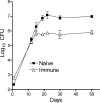

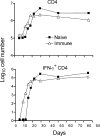
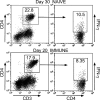
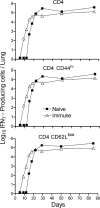
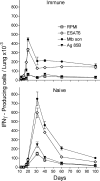
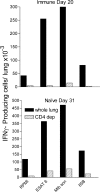

References
-
- Corbett, E.L., C.J. Watt, N. Walker, D. Maher, B.G. Williams, M.C. Raviglione, and C. Dye. 2003. The growing burden of tuberculosis: global trends and interactions with the HIV epidemic. Arch. Intern. Med. 163:1009–1021. - PubMed
-
- Orme, I.M. 1999. Beyond BCG: the potential for a more effective TB vaccine. Mol. Med. Today. 5:487–492. - PubMed
-
- Flynn, J.L., and J. Chan. 2001. Immunology of tuberculosis. Annu. Rev. Immunol. 19:93–129. - PubMed
-
- North, R.J., and Y.J. Jung. 2004. Immunity to tuberculosis. Annu. Rev. Immunol. 22:599–623. - PubMed
-
- Farer, L.S., A.M. Lowell, and W.B. Meador. 1979. Extrapulmonary tuberculosis in the United States. Am. J. Epidemiol. 109:205–217. - PubMed
Publication types
MeSH terms
Substances
Grants and funding
LinkOut - more resources
Full Text Sources
Medical
Research Materials

